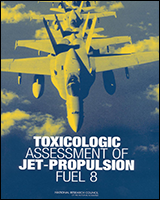NCBI Bookshelf. A service of the National Library of Medicine, National Institutes of Health.
This book provides a critical review of toxicologic, epidemiologic, and other relevant data on jet-propulsion fuel 8, a type of fuel in wide use by the U.S. Department of Defense (DOD), and an evaluation of the scientific basis of DOD’s interim permissible exposure level of 350 mg/m3.
Contents
- THE NATIONAL ACADEMIES
- SUBCOMMITTEE ON JET-PROPULSION FUEL 8
- COMMITTEE ON TOXICOLOGY
- BOARD ON ENVIRONMENTAL STUDIES AND TOXICOLOGY
- OTHER REPORTS OF THE BOARD ON ENVIRONMENTAL STUDIES AND TOXICOLOGY
- OTHER REPORTS OF THE COMMITTEE ON TOXICOLOGY
- Preface
- Abbreviations
- Summary
- 1. Introduction
- 2. Dosimetry and Exposure Assessment of Jet-Propulsion Fuel 8
- 3. Toxicokinetics and Toxicodynamics of Jet-Propulsion Fuel 8
- BENZENE
- ALKYLBENZENES
- C9-C13 ALIPHATIC AND AROMATIC HYDROCARBONS
- PHYSIOLOGICALLY BASED PHARMACOKINETIC MODELS OF BENZENE, NONANE, AND C9-C12 OR C9-C17 ALIPHATIC HYDROCARBONS
- TOXICOKINETICS-RELATED INTERACTIONS AMONG HYDROCARBON FUEL COMPONENTS
- TOXICOKINETIC-RELATED INDIVIDUAL SUSCEPTIBILITY FACTORS
- REFERENCES
- 4. Effects of Jet-Propulsion Fuel 8 on the Respiratory Tract
- 5. Effects of Jet-Propulsion Fuel 8 on the Nervous System
- 6. Effects of Jet-Propulsion Fuel 8 on the Immune System
- 7. Effects of Jet-Propulsion Fuel 8 on the Liver
- 8. Effects of Jet-Propulsion Fuel 8 on the Kidney
- 9. Effects of Jet-Propulsion Fuel 8 on Reproduction and Development
- 10. Effects of Jet-Propulsion Fuel 8 on the Cardiovascular System
- 11. Genotoxic Effects of Jet-Propulsion Fuel 8
- 12. Carcinogenic Effects of Jet-Propulsion Fuel 8
- Appendix A Permissible Exposure Levels for Selected Military Fuel Vapors: Contents and Executive Summary (NRC 1996)
- Appendix B JP-8 Final Risk Assessment: Contents, Executive Summary, and Introduction (TIEHH 2001)
- Appendix C Review of Tests Assessing Neurologic Function in Persons Exposed to Jet Fuels
This project was supported by Contract No. DAMD17-99-C-9049 between the National Academy of Sciences and U.S. Department of Defense. Any opinions, findings, conclusions, or recommendations expressed in this publication are those of the author(s) and do not necessarily reflect the view of the organizations or agencies that provided support for this project.
NOTICE: The project that is the subject of this report was approved by the Governing Board of the National Research Council, whose members are drawn from the councils of the National Academy of Sciences, the National Academy of Engineering, and the Institute of Medicine. The members of the committee responsible for the report were chosen for their special competences and with regard for appropriate balance.
- NLM CatalogRelated NLM Catalog Entries
- Review Biological and health effects of exposure to kerosene-based jet fuels and performance additives.[J Toxicol Environ Health B Cri...]Review Biological and health effects of exposure to kerosene-based jet fuels and performance additives.Ritchie G, Still K, Rossi J 3rd, Bekkedal M, Bobb A, Arfsten D. J Toxicol Environ Health B Crit Rev. 2003 Jul-Aug; 6(4):357-451.
- Exposure to low levels of jet-propulsion fuel impairs brainstem encoding of stimulus intensity.[J Toxicol Environ Health A. 2014]Exposure to low levels of jet-propulsion fuel impairs brainstem encoding of stimulus intensity.Guthrie OW, Xu H, Wong BA, McInturf SM, Reboulet JE, Ortiz PA, Mattie DR. J Toxicol Environ Health A. 2014; 77(5):261-80.
- Review Review of the Department of Defense Biokinetic Modeling Approach in Support of Establishing an Airborne Lead Exposure Limit[ 2020]Review Review of the Department of Defense Biokinetic Modeling Approach in Support of Establishing an Airborne Lead Exposure LimitNational Academies of Sciences, Engineering, and Medicine; Division on Earth and Life Studies; Board on Environmental Studies and Toxicology; Committee to Review DoD's Proposed Occupational Exposure Limits for Lead. 2020 Mar 30
- The Department of Defense at the Forefront of a Global Health Emergency Response: Lessons Learned from the Ebola Outbreak.[Health Secur. 2016]The Department of Defense at the Forefront of a Global Health Emergency Response: Lessons Learned from the Ebola Outbreak.Diehl G, Bradstreet N, Monahan F. Health Secur. 2016 Sep-Oct; 14(5):366-74.
- Review Standardizing Medication Error Event Reporting in the U.S. Department of Defense.[Advances in Patient Safety: Fr...]Review Standardizing Medication Error Event Reporting in the U.S. Department of Defense.Nosek RA Jr, McMeekin J, Rake GW. Advances in Patient Safety: From Research to Implementation (Volume 4: Programs, Tools, and Products). 2005 Feb
- Toxicologic Assessment of Jet-Propulsion Fuel 8Toxicologic Assessment of Jet-Propulsion Fuel 8
Your browsing activity is empty.
Activity recording is turned off.
See more...
